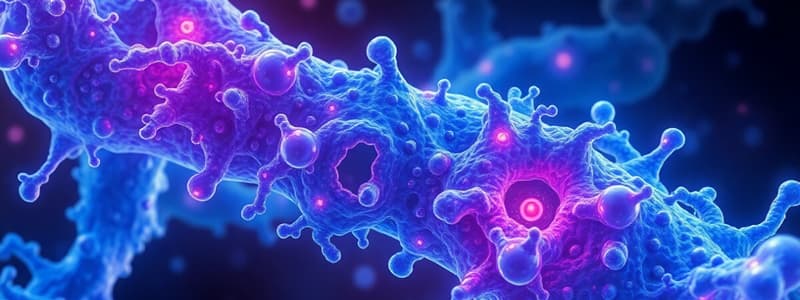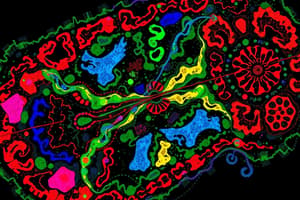Podcast
Questions and Answers
Which statement correctly describes the role of chaperon BiP?
Which statement correctly describes the role of chaperon BiP?
- BiP promotes the dimerization of IRE1.
- BiP binds only to unfolded proteins without interacting with IRE1.
- BiP assists in the proper folding of proteins. (correct)
- BiP is a prokaryotic protein that degrades proteins.
What is the main function of the proteasome in protein degradation?
What is the main function of the proteasome in protein degradation?
- To catalyze the synthesis of new proteins.
- To solely assist in protein folding.
- To degrade ubiquitinated proteins into peptides. (correct)
- To recycle proteins back into their original shape.
Which of the following is NOT a consideration in the degradation process?
Which of the following is NOT a consideration in the degradation process?
- Maintenance of dynamic homeostasis of structural proteins.
- Spatial and temporal control of protein degradation.
- Necessity of compartmentalization in prokaryotes.
- Universal presence of proteasomes in all living organisms. (correct)
What role does PERK play in the response to unfolded proteins?
What role does PERK play in the response to unfolded proteins?
How is ubiquitination involved in the process of ERAD?
How is ubiquitination involved in the process of ERAD?
What is the primary role of the proteasome in cellular function?
What is the primary role of the proteasome in cellular function?
What does ERAD stand for in the context of protein management?
What does ERAD stand for in the context of protein management?
What can trigger the Unfolded Protein Response (UPR)?
What can trigger the Unfolded Protein Response (UPR)?
Which class of disease is characterized by loss of function of a protein through mutation?
Which class of disease is characterized by loss of function of a protein through mutation?
How does the presence of mutated proteins impact the endoplasmic reticulum?
How does the presence of mutated proteins impact the endoplasmic reticulum?
What is the primary role of the proteasome in protein degradation?
What is the primary role of the proteasome in protein degradation?
What is one function of chaperones in the context of the proteasome?
What is one function of chaperones in the context of the proteasome?
What does UPR stand for and what is its role in the cell?
What does UPR stand for and what is its role in the cell?
What process is primarily responsible for directing proteins to the proteasome for degradation?
What process is primarily responsible for directing proteins to the proteasome for degradation?
Which disease is associated with dysfunctional CFTR protein linked to proteasome activity?
Which disease is associated with dysfunctional CFTR protein linked to proteasome activity?
What can be a consequence of an overloaded endoplasmic reticulum?
What can be a consequence of an overloaded endoplasmic reticulum?
What is one potential consequence of improperly folded proteins aggregating in eukaryotic cells?
What is one potential consequence of improperly folded proteins aggregating in eukaryotic cells?
Which of the following statements about the proteasome is accurate?
Which of the following statements about the proteasome is accurate?
How does the endoplasmic reticulum (ER) assist in protein degradation?
How does the endoplasmic reticulum (ER) assist in protein degradation?
What role do chaperons play in protein management within the cell?
What role do chaperons play in protein management within the cell?
What can be a consequence of glycation on proteins?
What can be a consequence of glycation on proteins?
What is the primary function of reverse chaperons in the degradation process?
What is the primary function of reverse chaperons in the degradation process?
Which factor is critical for the assembly and function of the proteasome?
Which factor is critical for the assembly and function of the proteasome?
What is one risk associated with the degradation process within the cell?
What is one risk associated with the degradation process within the cell?
How does PERK contribute to the response to unfolded proteins?
How does PERK contribute to the response to unfolded proteins?
Which of the following statements accurately describes the role of the endoplasmic reticulum (ER) in protein degradation?
Which of the following statements accurately describes the role of the endoplasmic reticulum (ER) in protein degradation?
What happens when the load on the endoplasmic reticulum (ER) exceeds its capacity?
What happens when the load on the endoplasmic reticulum (ER) exceeds its capacity?
Which process is crucial for tagging proteins to be degraded in the proteasome?
Which process is crucial for tagging proteins to be degraded in the proteasome?
What is one role of chaperones in the context of the proteasome?
What is one role of chaperones in the context of the proteasome?
What can be a direct consequence of a defect in the Unfolded Protein Response (UPR)?
What can be a direct consequence of a defect in the Unfolded Protein Response (UPR)?
Which type of cellular stress can trigger the Unfolded Protein Response (UPR)?
Which type of cellular stress can trigger the Unfolded Protein Response (UPR)?
What is the primary consequence of ERAD (Endoplasmic Reticulum Associated Destruction)?
What is the primary consequence of ERAD (Endoplasmic Reticulum Associated Destruction)?
How does the proteasome assist in maintaining cellular homeostasis?
How does the proteasome assist in maintaining cellular homeostasis?
What role does the UPR play in the response to endoplasmic reticulum stress?
What role does the UPR play in the response to endoplasmic reticulum stress?
Which of the following correctly describes a function of chaperons during protein degradation?
Which of the following correctly describes a function of chaperons during protein degradation?
What is the role of the proteasome in the context of cellular protein management?
What is the role of the proteasome in the context of cellular protein management?
In the process of ER-associated degradation (ERAD), what is the initial step taken for misfolded proteins?
In the process of ER-associated degradation (ERAD), what is the initial step taken for misfolded proteins?
What occurs during the unfolded protein response (UPR)?
What occurs during the unfolded protein response (UPR)?
Which statement about proteasome structure is accurate?
Which statement about proteasome structure is accurate?
What is a common consequence of improperly folded proteins in eukaryotic cells?
What is a common consequence of improperly folded proteins in eukaryotic cells?
Which condition can lead to the activation of the unfolded protein response (UPR)?
Which condition can lead to the activation of the unfolded protein response (UPR)?
How does glycation affect proteins, according to common findings?
How does glycation affect proteins, according to common findings?
Flashcards
BiP (Binding Immunoglobulin Protein)
BiP (Binding Immunoglobulin Protein)
A protein chaperone that binds to unfolded proteins or to the IRE1 protein in the ER, playing a key role in the unfolded protein response (UPR).
Unfolded Protein Response (UPR)
Unfolded Protein Response (UPR)
A system in the ER that helps maintain protein homeostasis by detecting and responding to misfolded or unfolded proteins.
ERAD (ER-associated Degradation)
ERAD (ER-associated Degradation)
A protein that is responsible for degrading misfolded or damaged proteins in the ER. It is also involved in the process of ubiquitination, marking proteins for degradation by the proteasome.
Proteasome
Proteasome
Signup and view all the flashcards
Ubiquitination
Ubiquitination
Signup and view all the flashcards
Protein Degradation
Protein Degradation
Signup and view all the flashcards
ER-associated Degradation (ERAD)
ER-associated Degradation (ERAD)
Signup and view all the flashcards
Intracellular Proteolysis
Intracellular Proteolysis
Signup and view all the flashcards
Protein Destruction
Protein Destruction
Signup and view all the flashcards
Chaperons
Chaperons
Signup and view all the flashcards
What is the UPR?
What is the UPR?
Signup and view all the flashcards
What is ERAD?
What is ERAD?
Signup and view all the flashcards
What is the proteasome?
What is the proteasome?
Signup and view all the flashcards
What is ubiquitination?
What is ubiquitination?
Signup and view all the flashcards
What triggers ER stress?
What triggers ER stress?
Signup and view all the flashcards
How does the UPR respond to ER stress?
How does the UPR respond to ER stress?
Signup and view all the flashcards
What is the importance of ERAD?
What is the importance of ERAD?
Signup and view all the flashcards
What are the consequences of defects in UPR/ERAD?
What are the consequences of defects in UPR/ERAD?
Signup and view all the flashcards
Proteasome Function
Proteasome Function
Signup and view all the flashcards
Importance of UPR/ERAD
Importance of UPR/ERAD
Signup and view all the flashcards
Consequences of defects in UPR/ERAD
Consequences of defects in UPR/ERAD
Signup and view all the flashcards
ER Capacity and Charge
ER Capacity and Charge
Signup and view all the flashcards
Stress on the ER
Stress on the ER
Signup and view all the flashcards
Glycosylation
Glycosylation
Signup and view all the flashcards
Glycation
Glycation
Signup and view all the flashcards
Study Notes
Protein Degradation - Proteasome
- Protein degradation is essential for cellular function.
- The unfolded protein response (UPR) is a cellular response to an increase in unfolded proteins in the endoplasmic reticulum.
- ER-associated degradation (ERAD) is a pathway that targets misfolded proteins in the ER for degradation by the proteasome.
- Ubiquitination is a process that marks proteins for degradation by the proteasome.
- Proteasomes are large protein complexes that degrade target proteins.
- Proteasome assembly and structure are critical functions.
- The proteasome and chaperones work together in folding and destruction.
- Eukaryotes may have up to 30% misfolded proteins at a time.
- Toxic protein aggregates can be dominant negatives.
- Misfolding can occur due to mutations, or post-synthetic damage (e.g., oxidation, glycation, deamidation).
- There are ~50 diseases linked to UPS/ERAD which can also result in apoptosis.
Proteasome Overview
- Proteasomes are involved in a range of cellular processes, far beyond the degradation of misfolded proteins.
- Regulation of protein degradation provides homeostasis.
- Protein control systems ensure accuracy and function are vital.
- Protection of other cellular components is crucial, especially in bacteria that lack compartments.
- Efficient machinery (auto-assembly, auto-organization) is needed.
- Proteins destined for degradation in the ER require specific mechanisms to exit the ER, including the UPR and ERAD pathways.
- The pathways are crucial for maintaining cellular health and function, influencing cellular processes such as immune response and antigen presentation.
- Different types of ubiquitination (mono, multi- and poly-ubiquitination) can occur.
Ubiquitination
- Ubiquitination is a crucial step in protein degradation.
- Ubiquitination involves the attachment of a small protein called ubiquitin to a target protein. This can take different forms(mono, multi, poly).
- Ubiquitination can be mono-, multi-, or poly-ubiquitination, with different outcomes.
- Proteasomes recognize poly-ubiquitinated proteins for degradation.
Protein Degradation - Proteasome, Further considerations
- Ubiquitination is essential for protein degradation.
- The proteasome complex plays an important role in protein turnover within cells.
- Spacial and temporal control is important during protein degradation, with compartments protecting cells from damage.
- Compartmentalization protects cells from unwanted proteolysis damaging the cell.
- Chaperones are needed for unfolding and to assist cells in protein folding.
- The ER is not a degradation compartment but assists in the protein degradation process by chaperones and assistance mechanisms before a target protein can be degraded.
ERAD
- ERAD is involved in degrading misfolded proteins in the endoplasmic reticulum (ER).
- The process is tightly linked to folding and quality control.
- ERAD plays a role in numerous cellular processes and requires different steps (induction/attenuation, retrotransport, degradation).
- ERAD is an important quality control mechanism, ensuring proper function of proteins involved in various cellular processes.
Proteasomes: Steps in degradation
- Binding
- Unfolding
- Translocation and hydrolysis
- Release
Proteasome: Structure and Components
- PA700, PA28, and other components are related to this.
- Proteasome inhibitors can be a topic of therapeutic interest.
Proteasome: Other Aspects
- Ubiquitin-like modifications (UBLs) are involved in protein regulation, transport, and degradation.
- SUMO and NEDD8 are examples of UBLs with different roles and functions.
- The different forms of ubiquitination allow different types of regulatory functions.
- The structure of the proteasome is critical for its function, particularly the proteolytic chambers.
- Proteasome chambers and their function are important to study, involving high-resolution EM, interactions with other proteins, cross-linking, X-ray, and NMR analysis.
- Proteins can be acetylated for modification or as a signal for their degradation. Note that acetylation can impact protein folding, localization, and potentially degradation.
Studying That Suits You
Use AI to generate personalized quizzes and flashcards to suit your learning preferences.
Related Documents
Description
Explore the essential role of proteasomes in protein degradation and cellular function. This quiz delves into concepts such as ubiquitination, the unfolded protein response, and ER-associated degradation pathways. Understand how misfolded proteins are targeted for degradation and the significant impact on cellular processes.



